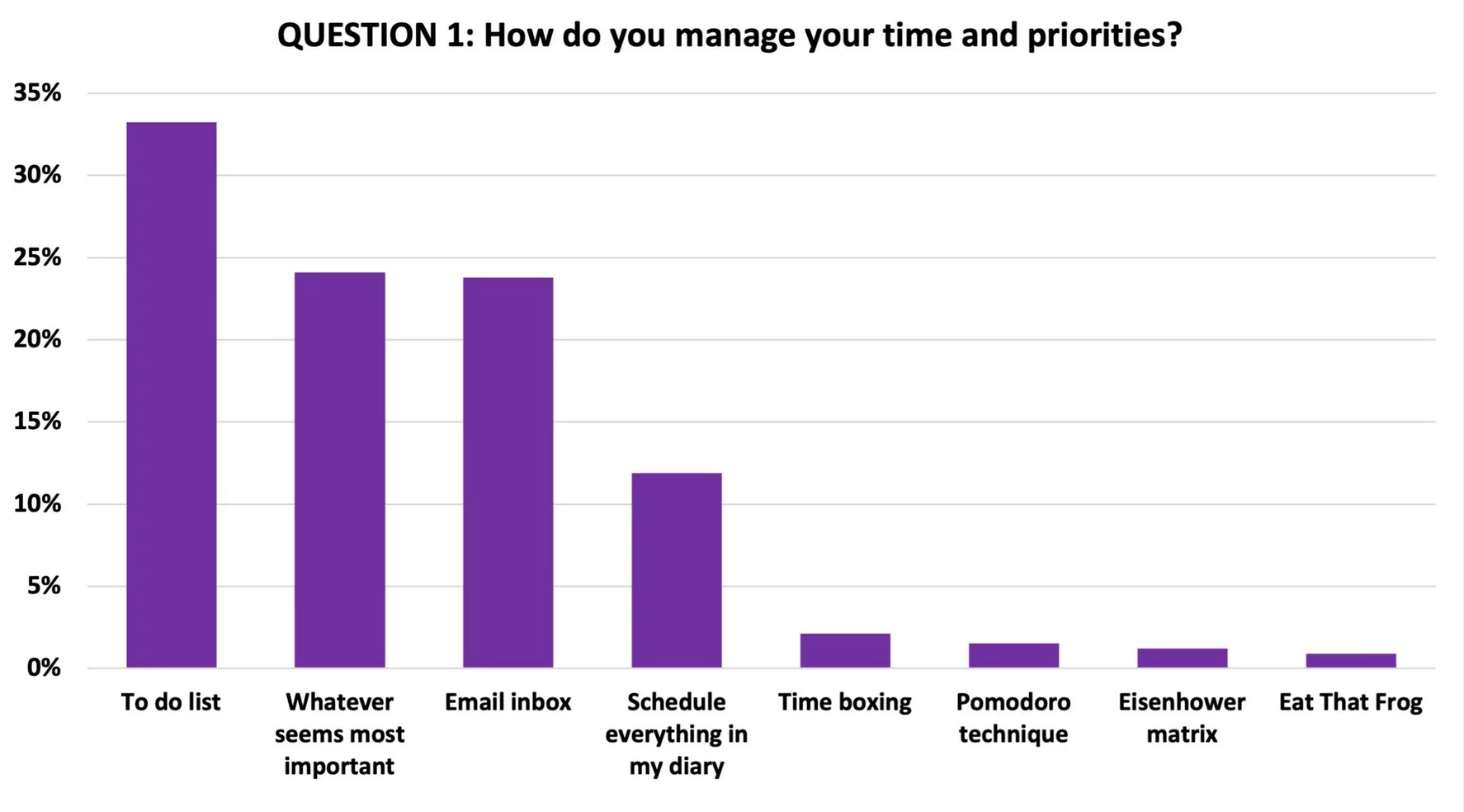
Time Management Statistics: Original Independent Research
How are people managing their time?
We conducted some bespoke research to see!
Key Takeaways: Time Management Statistics
- Less than 1 in 5 people have a proper time management system (18%).
- Over 80% of people don’t have any time management system!
- The Eisenhower Matrix is the most successful time management technique.
- 100% of people that use this technique feel their work is under control 4 or 5 days a week!
- 1 in 8 people never in control at work.
The real-world data helps us when we’re developing our time management training courses.
For more details of our sample size and methodology, see the bottom of this article.
Let’s take a look at what we found in more detail.
QUESTION 1: How Do You Manage Your Time And Tasks?
1: 18% of people have a dedicated Time Management system.
82% of people do not have a dedicated Time Management system.
2: 33% of people use a To Do List to manage their time and tasks.
3: 24% of people use their Email Inbox as their time and Task Management system.
4: 12% of people schedule all of their tasks in their diary in advance.
5: 25% of people “Just deal with whatever seems most important at the time”.
QUESTION 2: How Often Do Things Feel Under Control At Work?
1: 20% of people feel that their work is under control every day
2: 66% (2/3rds) of people feel that their work is under control most of the time (at least 3 days per week)
3: Over 20% (21%) feel that their work is either never under control or only under control 1 day per week.
4: More than 10% of people (1 in 8) feel that their work is never under control.
ANALYSIS: Best & Worst Time Management Techniques
1: “Just dealing with whatever comes up” is the least successful time management strategy.
More than 1 in 4 (28%) of people using this feel their work is either never under control or only under control one day per week.
2: The Eisenhower Matrix is the most successful strategy.
50% of people our respondents that use the Eisenhower Matrix feel their work is under control every single day!
The other 50% of respondents feel their work is under control 4 days a week.
3: The Pomodoro Technique is the second most successful time management strategy.
60% of people using this technique feel that their work is under control either 4 or 5 days a week!
An Eisenhower matrix worksheet can be found at the bottom of our time management course page.
New line managers on our line management training course often comment that they find that their workload can be overwhelming initially. We recommend that they use an Eisenhower matrix to map out exactly what tasks they have to manage and which ones are the most urgent and important.
QUESTION 3: Have You Ever Carried Out A Time Audit?
1: 1 In 5 People carry out a time audit regularly (once per month at least) to see how they are spending their time.
2: Almost 1 in 3 (31%) of people carry one out occasionally.
3: Almost half (49%) of people have never carried out a time audit to understand how they spend their time.
For details on how to carry out a time audit, please see our article: how to carry out a time audit.
Alternatively, note down in Excel every 15 minutes what you’ve been spending your time on and use that information to create a chart. Not sure how to? We run a number of different Excel training courses.
Obviously, before you can think about improving your time management you need to understand where your time is currently going.
The average working person has never even looked at how they spend their time – a recipe for poor time management.
QUESTION 4: How Much Time Do You Spend On Tasks & Meetings That Aren’t Important To Your Role?
1. On average, people “waste” 1 and a 1/2 hours (91 minutes) each day on tasks and meetings that aren’t important to their role.
2. Almost 2 in 5 (39%) of people spend less than an hour per day on tasks and meetings not important to their role.
3. Over 10% (10.5%) “waste” more than a third (37.5) of their time on tasks and meetings not important to their role.
4. There was no significant difference between people using different time management systems, except time boxing.
ANALYSIS: How Much Time Do You Spend On Work Tasks That Aren’t Important?
1. People who use timeboxing to manage their time on average “waste” 2 hours and 20 minutes per day on tasks not relevant to their key priorities.
2. There was no significant difference between the results to people using all the other time management techniques.
The average full-time worker spends up to 12.5% of their average workday on low-impact activities and unnecessary meetings where no meaningful communication takes place.
A simple place to start with time management if implementing a time management system feels overwhelming is to focus on cutting out the activities that are a waste of time.
Saving only one hour per week on average amounts to a 2.5% increase in your productive time (assuming eight hours in a working day). If that time is then focused on your most important tasks because you have implemented some good time management strategies it will make an even larger difference.
QUESTION 5: How Many Times Per Day Do You Look At Your Email?
1. On average, people look at their emails every hour and forty minutes (101 minutes) but there are big differences!
2. 1 in 6 people (16.6%) said they “live in email” as it is their primary work tool.
3. Over 50% (51%) of people look at their emails at least every 20 minutes in the working day.
4. 19% of people look at their emails at least once an hour.
5. Almost 20% (19.4%) of people look at their emails either only once per day or less than once per day.
ANALYSIS: How Many Times Per Day Do You Look At Your Email?
1. People who “Just do whatever seems most important” look at their emails the least. On average, they look every 2 hours and 13 minutes!
2. People who use email as their main task management tool look at their emails most often, on average looking every 56 minutes.
Managing email is one of the keys to personal productivity.
The amount of time wasted through repetitive email checking is huge.
As with cutting out wasted time, another very simple way to better time management skills is to reduce how often you check your email. Some time management apps have focus features that can help you achieve this.
Time Management Research Details
The research for these statistics was carried out using Pollfish. 500 people were surveyed.
It polled a representative sample of working people.
It was evenly split between males (46%) and females (54%).
The research was evenly split between age groups, with 20% of the replies being received from people in each of the following age categories:
- 18-24
- 25-34
- 35-44
- 45-54
- 54-65
Looking for more on Time Management? Try this article on The Seinfeld Strategy or this one on Mastering Productivity!
- Facebook: https://www.facebook.com/profile.php?id=100066814899655
- X (Twitter): https://twitter.com/AcuityTraining
- LinkedIn: https://www.linkedin.com/company/acuity-training/







